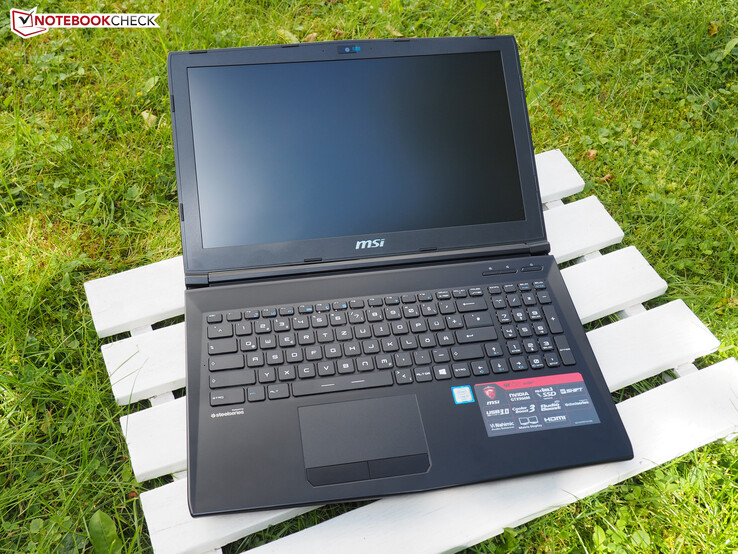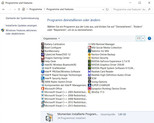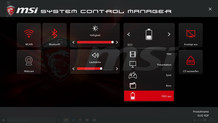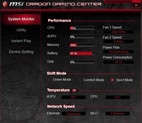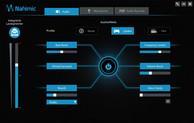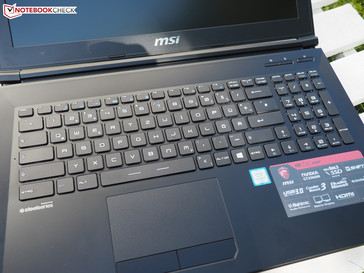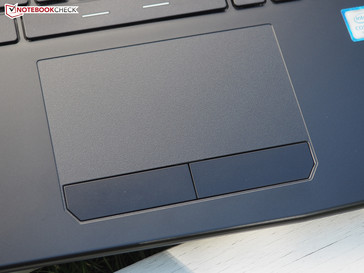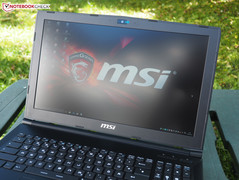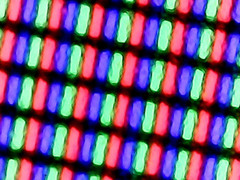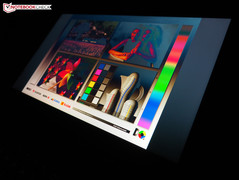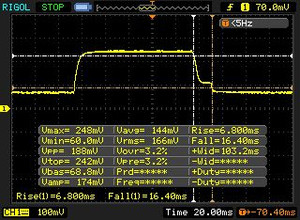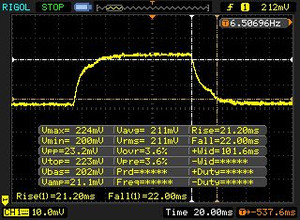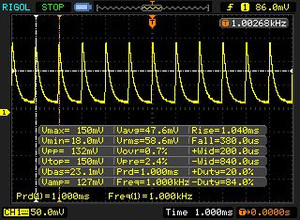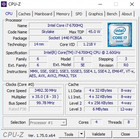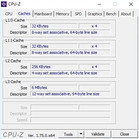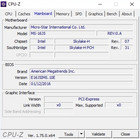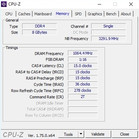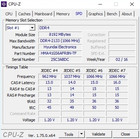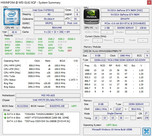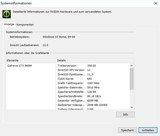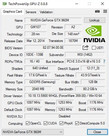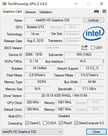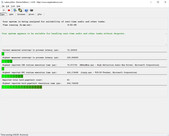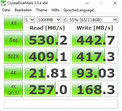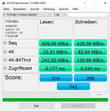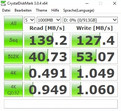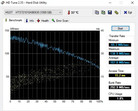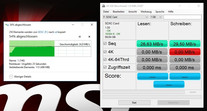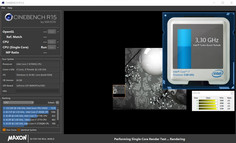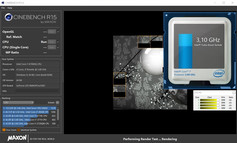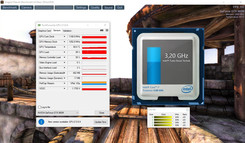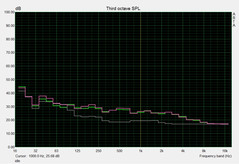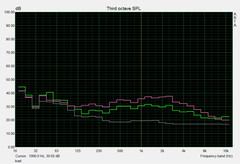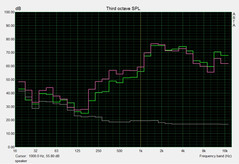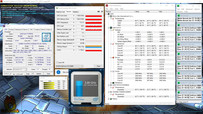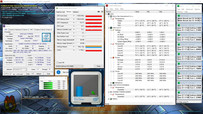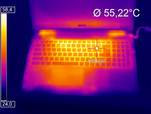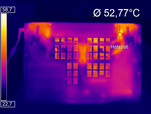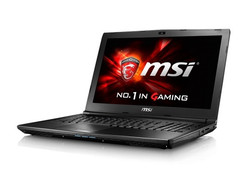MSI GL62 6QF Notebook Review
For the original German review, see here.
"Gaming starts here” is MSI’s slogan to advertise the pretty inexpensive GL62. Compared to other models from the GE or GS series, however, the manufacturer has cut some corners. For example, the 15-inch model lacks a keyboard illumination as well as an IPS display.
The other features are also pretty mediocre. If you look at the models listed by the Internet shop notebooksbilliger.de, which provided the test sample, you only get 8 GB DDR4 RAM, a DVD burner (no Blu-ray drive) and a TN panel with 1920x1080 pixels. You do not get a high-end GPU, either. After the launch of the Nvidia GTX 980, the GTX 960M is more of an upper mainstream chip. Depending on the model, the processor is either a Core i5-6300HQ or the Core i7-6700HQ. MSI uses solid-state drives, conventional hard drives or a combination of both as storage solutions.
The biggest advantage of the GL62 is the fair price. Not every manufacturer offers gaming devices priced between 900 and 1100 Euros (~$997 and ~$1218). The competition is still pretty tough for the 15-inch notebook. Whether it is the Asus G501VW or the Acer V15 Nitro, comparable configurations are hardly more expensive. Our review sample, priced at 1100 Euros (~$1218) is based on the model GL62-6QFi78H11 and competes directly with the recently launched HP Omen.
Case
Both the design and the port selection of the GL62 are reminiscent of the 15-inch sibling GE62. We have already mentioned that there is no keyboard illumination for the cheaper model. Another difference is the materials used. While some parts of the GE62 are made of metal, the GL62 is made entirely of plastic and as a result does not appear quite as sophisticated.
Otherwise, the case leaves a decent impression. The stability could be better here and there (wobbly lid, the area around the optical drive can be pushed in), but the build quality meets the price. Thanks to a moderate weight of 2.3 kilograms (~5.1 lb) and the comparatively slim construction (2.9 cm/~1.14 in), it is not hard to transport. The hinges are also good, but you can notice some bounces caused by vibrations.
Unlike some other MSI notebooks, the design is surprisingly subtle. The manufacturer mainly uses the color black, and we can only find some red elements on the lid and the bottom. Our overall rating for the case is “Satisfactory”.
Connectivity
Ports
There is hardly any criticism for MSI in terms of the port selection. Except for the somewhat impractical layout (many ports are at the left front), the connectivity is satisfactory. While RJ45-Ethernet, Kensington Lock, two audio jacks and two video ports are essential for a gaming notebook, four USB ports are hardly a matter of course, especially since MSI has implemented two USB 3.0 Type-C ports (but no USB 3.1 Gen. 2!).
Card Reader
We are disappointed by the performance of the card reader. A mere 27 to 30 MB/s in the sequential AS SSD Benchmark test and 25 MB/s when we copy 250 jpg files are pretty low. Most gaming notebooks manage more than 70 MB/s. Our reference card (Toshiba Exceria Pro SDXC 64 GB UHS-II) could manage up to 260 MB/s.
Communication
MSI uses the WLAN module Wireless-AC 3165 from Intel. As befits a modern gaming notebook, the module supports WLAN 802.11 a/b/g/n as well as the ac standard (2.4 & 5 GHz, up to 433 Mbps) besides Bluetooth. The range was average during our test. At a distance of 10 meters (~33 ft) to the router and through several walls, Windows indicated 70 Mbps (4/5 bars).
Maintenance
The maintenance of the GL62 leaves mixed impressions. It is a pity that MSI does not implement a corresponding hatch. If you want to tinker a little or upgrade parts, you can still remove the whole bottom panel. A damaged warranty seal should not be a problem in Germany, as long as the maintenance work was performed by experienced personnel. As you can see on the pictures of the GL72 (link), you can access the battery, cooling system, both RAM slots, the 2.5-inch slot and the M.2 slot. Processor and graphics card are soldered, which is normal by now.
Software
MSI has equipped the GL62 with various applications and tools. Below, we have included screenshots from three examples. In addition to the System Control Manager, the Dragon Gaming Center is interesting. The latter includes several monitoring and special functions such as the Shift mode, which adjusts the clock behavior of the CPU and the GPU depending on the setting (Green, Comfort & Sport). The sound can be optimized via Nahimic Sound Enhancer. Office 365 and Norton Security are included as trial versions. Movie enthusiasts will be happy about CyberLink Power DVD 12.
Accessories
The accessories are limited to a quick-start guide, a warranty manual and some service brochures. MSI has included a 120-watt power adapter (14.5 x 7.5 x 2.5 cm/~5.7 x 2.9 x 1 in), weighting at 464 grams (~1 lb).
Warranty
The warranty period is 24 months (Collect & Return Service).
Input Devices
Keyboard
The keyboard is a matter of taste. Once again, MSI is using a very unconventional layout. The German version also gets a single-line Return key, so the #-key has been shifted. Because of the oversized Shift key, <|> is moved right next to the space bar. This means that users of classic layouts will have to get used to the keyboard.
The typing experience is as good as the GE62; pressure point and stroke will be satisfactory for most users. The same applies for the typing noise, which is not very loud in the case of the GL62 – quite the contrary. The key size varies between a generous (15 x 15 mm @main keys/~0.6 x 0.6 mm) and a rather narrow (12 x 15 mm @numbers pad/~0.47 x 0.6 in). The F-keys are also smaller, which is typical for notebooks. Great: MSI uses the arrow keys for the volume and brightness control, which results in a more comfortable and simple use. Speaking of comfort: The keyboard is located pretty far at the top, so users get a decently-sized palm rest.
Touchpad
We would call the mouse replacement convenient. MSI has implemented a conventional touchpad with precise, but very loud buttons. Considering a width of 10.5 and a height of 6 cm (~4.1 and 2.4 in respectively), the size is okay. The surface is slightly textured, which is visible in the close-ups. It improves the feedback and the precision without affecting the gliding capabilities significantly.
Obviously, the touchpad supports several gestures starting with zooming up to turning gestures. Attention: For some reason, scrolling with two fingers is deactivated by default and has to be enabled in the Synaptics software first (touchpad icon in the notification area). Gestures work great except for the rather tricky zoom.
Display
To put it mildly: The picture quality cannot meet our expectations. Many competitors offer IPS displays, but MSI only implements a TN-panel, CMN N156HGE-EAL. The latter offers wide color gamut (100% sRGB, 75% AdobeRGB), but disappoints in the other areas.
| |||||||||||||||||||||||||
Brightness Distribution: 83 %
Center on Battery: 216 cd/m²
Contrast: 450:1 (Black: 0.48 cd/m²)
ΔE ColorChecker Calman: 9.98 | ∀{0.5-29.43 Ø4.77}
ΔE Greyscale Calman: 10.91 | ∀{0.09-98 Ø5}
100% sRGB (Argyll 1.6.3 3D)
75% AdobeRGB 1998 (Argyll 1.6.3 3D)
84.1% AdobeRGB 1998 (Argyll 3D)
99.8% sRGB (Argyll 3D)
85.8% Display P3 (Argyll 3D)
Gamma: 2.31
CCT: 13185 K
| MSI GL62-6QFi781H11 CMN N156HGE-EAL (CMN15D2) | Acer Aspire V15 Nitro BE VN7-592G-79DV Sharp LQ156D1JW02D | Asus G501VW-FY081T Samsung 156HL01-104 | Gigabyte P55K v5 Name: AU Optronics B156HAN01.2, ID: AUO12ED | Schenker XMG A516 LG Philips LP156WF6 (LGD046F) | HP Omen 15-ax007ng LGD0519 | |
|---|---|---|---|---|---|---|
| Display | 6% | -14% | -16% | -23% | -36% | |
| Display P3 Coverage (%) | 85.8 | 86.2 0% | 66.8 -22% | 65.9 -23% | 64.7 -25% | 59.9 -30% 40.34 -53% |
| sRGB Coverage (%) | 99.8 | 100 0% | 97.3 -3% | 91 -9% | 83.2 -17% | 85.9 -14% 60.3 -40% |
| AdobeRGB 1998 Coverage (%) | 84.1 | 99.5 18% | 68.6 -18% | 60.8 -28% | 61.6 -27% 41.73 -50% | |
| Response Times | -12% | -43% | -7% | 1% | -32% | |
| Response Time Grey 50% / Grey 80% * (ms) | 43 ? | 49 ? -14% | 50 ? -16% | 37.2 ? 13% | 41 ? 5% | 55 ? -28% |
| Response Time Black / White * (ms) | 23 ? | 25 ? -9% | 39 ? -70% | 29.2 ? -27% | 24 ? -4% | 31 ? -35% |
| PWM Frequency (Hz) | 1000 ? | 1000 ? | 200 ? | |||
| Screen | 57% | 43% | 30% | 39% | 13% | |
| Brightness middle (cd/m²) | 216 | 303 40% | 341 58% | 274.9 27% | 312 44% | 214 -1% |
| Brightness (cd/m²) | 202 | 291 44% | 312 54% | 259 28% | 303 50% | 203 0% |
| Brightness Distribution (%) | 83 | 83 0% | 83 0% | 72 -13% | 92 11% | 79 -5% |
| Black Level * (cd/m²) | 0.48 | 0.22 54% | 0.32 33% | 0.367 24% | 0.3 37% | 0.28 42% |
| Contrast (:1) | 450 | 1377 206% | 1066 137% | 749 66% | 1040 131% | 764 70% |
| Colorchecker dE 2000 * | 9.98 | 3.47 65% | 4.23 58% | 3.39 66% | 5.11 49% | 6.04 39% |
| Colorchecker dE 2000 max. * | 17.12 | 6.79 60% | 8.02 53% | 5.76 66% | 8.96 48% | 12 30% |
| Greyscale dE 2000 * | 10.91 | 1.17 89% | 4.69 57% | 4.21 61% | 4.41 60% | 5.91 46% |
| Gamma | 2.31 95% | 2.35 94% | 2.53 87% | 2.18 101% | 2.5 88% | 2.44 90% |
| CCT | 13185 49% | 6658 98% | 7549 86% | 6069 107% | 6789 96% | 7362 88% |
| Color Space (Percent of AdobeRGB 1998) (%) | 75 | 86 15% | 63 -16% | 59.2 -21% | 55 -27% | 38 -49% |
| Color Space (Percent of sRGB) (%) | 100 | 100 0% | 97 -3% | 90.9 -9% | 83 -17% | 60 -40% |
| Total Average (Program / Settings) | 17% /
38% | -5% /
20% | 2% /
18% | 6% /
21% | -18% /
-8% |
* ... smaller is better
This starts with the luminance, which is just 202 cd/m² on average. This might be sufficient indoors, but it is a problem when you go outside. The limited viewing angles are even more annoying. The picture does not appear very uniform, even when you are sitting perfectly – independent of the brightness distribution. Another drawback is the black value: 0.48 cd/m² will let dark movie and gaming sequences appear grayish.
The contrast ratio is therefore just 450:1 – very low compared to other gaming notebooks. The table above clearly shows the differences. The Asus G501VW as well as the Schenker XMG A516 and the Acer V15 Nitro manage contrasts of at least 1000:1.
It would be better if we do not talk about the color accuracy and the color balance. The picture is not even close to a natural presentation without calibrations. In short: MSI has definitely saved money in the wrong place; you should be able to expect a high-quality panel for a price of more than 1000 Euros (~$1107).
Display Response Times
| ↔ Response Time Black to White | ||
|---|---|---|
| 23 ms ... rise ↗ and fall ↘ combined | ↗ 7 ms rise | |
| ↘ 16 ms fall | ||
| The screen shows good response rates in our tests, but may be too slow for competitive gamers. In comparison, all tested devices range from 0.1 (minimum) to 240 (maximum) ms. » 51 % of all devices are better. This means that the measured response time is worse than the average of all tested devices (20.2 ms). | ||
| ↔ Response Time 50% Grey to 80% Grey | ||
| 43 ms ... rise ↗ and fall ↘ combined | ↗ 21 ms rise | |
| ↘ 22 ms fall | ||
| The screen shows slow response rates in our tests and will be unsatisfactory for gamers. In comparison, all tested devices range from 0.165 (minimum) to 636 (maximum) ms. » 70 % of all devices are better. This means that the measured response time is worse than the average of all tested devices (31.6 ms). | ||
Screen Flickering / PWM (Pulse-Width Modulation)
| Screen flickering / PWM detected | 1000 Hz | ≤ 80 % brightness setting | |
The display backlight flickers at 1000 Hz (worst case, e.g., utilizing PWM) Flickering detected at a brightness setting of 80 % and below. There should be no flickering or PWM above this brightness setting. The frequency of 1000 Hz is quite high, so most users sensitive to PWM should not notice any flickering. In comparison: 53 % of all tested devices do not use PWM to dim the display. If PWM was detected, an average of 8081 (minimum: 5 - maximum: 343500) Hz was measured. | |||
Performance
Mainstream gamers who do not necessarily desire to play every game at the highest settings should be satisfied with the GL62. Thanks to the solid-state disk, our test model 6QFi781H11 boots up quickly and the system is generally fast. 8 GB DDR4 RAM is no longer a highlight, but should still be okay in the next one or two years. It will be hard to bring the quad-core processor to its limits, because games are usually limited by the GPU.
Processor
The quad-core CPU from Intel's Skylake generation matches the gaming expectations. The Core i7-6700HQ can reach up to 3.5 GHz under load and up to 3.1 GHz when an application utilizes all four cores.
Cinebench R15 shows that the Turbo Boost is fully utilized most of the time. However, single-core scenarios cannot utilize the maximum, which is also supported by the results (slightly lower than the rivals).
The technical specifications of the Skylake chip are up to date. While Hyper-Threading is a familiar feature (eight instead of four threads simultaneously), since 2015 Intel chips are only manufactured in a 14 nm process. The TDP specified by the manufacturer is 45 watts.
System Performance
The system performance is inconspicuous. 5666 points in PCMark 7 are typical for a gaming notebook from the upper mainstream or the lower high-end segment, respectively. The Acer V17 Nitro with a Core i7-4720HQ, GeForce GTX 960M and 256 GB SSD manages a very similar score.
| PCMark 7 Score | 5666 points | |
| PCMark 8 Home Score Accelerated v2 | 3603 points | |
| PCMark 8 Creative Score Accelerated v2 | 4375 points | |
| PCMark 8 Work Score Accelerated v2 | 4951 points | |
Help | ||
| PCMark 7 - Score | |
| Schenker XMG A516 | |
| Acer Aspire V15 Nitro BE VN7-592G-79DV | |
| HP Omen 15-ax007ng | |
| MSI GL62-6QFi781H11 | |
| Asus G501VW-FY081T | |
| PCMark 8 | |
| Home Score Accelerated v2 | |
| HP Omen 15-ax007ng | |
| Gigabyte P55K v5 | |
| MSI GL62-6QFi781H11 | |
| Asus G501VW-FY081T | |
| Acer Aspire V15 Nitro BE VN7-592G-79DV | |
| Creative Score Accelerated v2 | |
| HP Omen 15-ax007ng | |
| Gigabyte P55K v5 | |
| Acer Aspire V15 Nitro BE VN7-592G-79DV | |
| Asus G501VW-FY081T | |
| MSI GL62-6QFi781H11 | |
| Work Score Accelerated v2 | |
| HP Omen 15-ax007ng | |
| Gigabyte P55K v5 | |
| MSI GL62-6QFi781H11 | |
| Asus G501VW-FY081T | |
| Acer Aspire V15 Nitro BE VN7-592G-79DV | |
Storage Devices
The storage solution caused some headaches during the review. The reason: Both AS SSD as well as CrystalDiskMark fluctuated heavily when they evaluated the performance of the 128 GB solid-state disk (Toshiba HG6). The best result for sequential writes was 430 to 440 MB/s, but around 100 to 200 MB/s in the worst case. We did not find the cause for this issue. Windows updates were not active during the benchmarks. There were no problems for the reading speeds. Up to 530 MB/s are similar to other SSDs with the SATA-III interface. You have to use solid-state disks based on the PCIe or NVMe technology, respectively, to increase the performance, but these drives are also more expensive.
MSI also includes a conventional hard drive to avoid space problems. The 1 TB drive from HGST (Travelstar 7K1000) performs pretty well. This is not surprising though, since it works at 7200 rpm.
| MSI GL62-6QFi781H11 Toshiba HG6 THNSNJ128G8NY | Acer Aspire V15 Nitro BE VN7-592G-79DV Lite-On CV1-8B512 M.2 512 GB | Asus G501VW-FY081T Samsung CM871 MZNLF128HCHP | Gigabyte P55K v5 SanDisk SD8SN8U1T001122 | Schenker XMG A516 Samsung SSD 950 Pro 256GB m.2 NVMe | HP Omen 15-ax007ng Adata IM2S3138E-128GM-B | |
|---|---|---|---|---|---|---|
| AS SSD | 1% | -46% | -5% | 166% | -8% | |
| Seq Read (MB/s) | 509 | 514 1% | 504 -1% | 467.6 -8% | 2005 294% | 478.3 -6% |
| Seq Write (MB/s) | 429.6 | 424.8 -1% | 126.9 -70% | 360.4 -16% | 916 113% | 161 -63% |
| 4K Read (MB/s) | 20.31 | 21.75 7% | 13.87 -32% | 25.09 24% | 48.47 139% | 29.31 44% |
| 4K Write (MB/s) | 82.9 | 67.9 -18% | 30.66 -63% | 46.73 -44% | 136.8 65% | 73.3 -12% |
| Score Total (Points) | 742 | 859 16% | 269 -64% | 868 17% | 2356 218% | 704 -5% |
GPU Performance
Gaming notebooks priced between 1000 and 1500 Euros (~$1107 and ~$1661) are primarily equipped with one of three graphics cards. While the GeForce GTX 965M has 1024 shaders, the less expensive siblings GTX 960M and GTX 950M get only 640 shaders. There are no differences in terms of memory interface, which is 128-bit in each case.
The amount of VRAM varies from notebook to notebook. Once again, MSI tries to save some money and has implemented the GTX 960M with 2 instead of 4 GB GDDR5-VRAM. This means that you cannot use the maximum settings in all games (like Hitman) or at least it is not recommended. However, the GTX 960M will have problems with higher details in general, and it does not matter if you have the 2 or 4 GB version.
| 3DMark 11 Performance | 5178 points | |
| 3DMark Ice Storm Standard Score | 64476 points | |
| 3DMark Cloud Gate Standard Score | 16887 points | |
| 3DMark Fire Strike Score | 3954 points | |
Help | ||
On the other hand, the GL62 can utilize the Turbo perfectly. According to GPU-Z even maximum load is handled with a core clock of 1189 instead of the normal 1097 MHz. Note: Nvidia's Maxwell generation will be replaced by Pascal soon. It might be worthwhile to wait for discounts on the GL62 or even a new model. Thanks to the architectural upgrade, the manufacturing process drops from 28 to 16 nm, which promises higher power efficiency.
| 3DMark | |
| 1920x1080 Fire Strike Score | |
| Schenker XMG A516 | |
| HP Omen 15-ax007ng | |
| Gigabyte P55K v5 | |
| Asus G501VW-FY081T | |
| Acer Aspire V15 Nitro BE VN7-592G-79DV | |
| MSI GL62-6QFi781H11 | |
| 1920x1080 Fire Strike Graphics | |
| Schenker XMG A516 | |
| HP Omen 15-ax007ng | |
| Gigabyte P55K v5 | |
| Asus G501VW-FY081T | |
| Acer Aspire V15 Nitro BE VN7-592G-79DV | |
| MSI GL62-6QFi781H11 | |
| Unigine Heaven 4.0 - Extreme Preset DX11 | |
| Schenker XMG A516 | |
| HP Omen 15-ax007ng | |
| MSI GL62-6QFi781H11 | |
Gaming Performance
We have already mentioned that the GTX 960M is not a high-end GPU, which can handle all games at maximum details. If you do not want to reduce the resolution and want to play in the native 1920x1080 pixels, you will often have to choose medium settings without anti-aliasing.
This is the case for some of the tested games including “Anno 2205”, “Assassin's Creed Syndicate”, “XCOM 2” and “Mirror's Edge Catalyst”. We would even recommend low details for “Doom” in FHD. “Need for Speed”, “Overwatch”, “FIFA 16” and “Rainbow Six Siege” can even be played with high details. However, the limitations would be much lower with the GTX 965M. The latter is – at least the 2016 model – about 30% faster on average.
We updated the GPU driver via GeForce Experience from version 359.00 to the brand-new ForceWare 368.39 for our gaming benchmarks.
| low | med. | high | ultra | |
|---|---|---|---|---|
| FIFA 16 (2015) | 177.8 | 145 | 103 | |
| Anno 2205 (2015) | 100.7 | 62.5 | 28.7 | 11.2 |
| Assassin's Creed Syndicate (2015) | 50.6 | 46.8 | 29.6 | 5.2 |
| Rainbow Six Siege (2015) | 162.7 | 111 | 57.5 | 45.7 |
| XCOM 2 (2016) | 66.1 | 32.1 | 20.1 | 8.7 |
| Hitman 2016 (2016) | 46.5 | 46 | 28.2 | 27.4 |
| Need for Speed 2016 (2016) | 70.7 | 67.4 | 40 | 28.4 |
| Doom (2016) | 69.4 | 57.2 | 33.6 | 28.4 |
| Overwatch (2016) | 184.9 | 142.3 | 69.1 | 39.7 |
| Mirror's Edge Catalyst (2016) | 96.2 | 61.8 | 30 | 24.3 |
Emissions
System Noise
Noise-sensitive users should avoid the GL62. The system is not too loud with 41 dB(A) while gaming and up to 46 dB(A) in the stress test, but the idle noise is unnecessarily high at 35 to 37 dB(A). Most gaming notebooks level off – if there is no pulsating – at around 32 dB(A).
The constant fan noise also hides the murmur of the hard drive. You can expect about 39 dB(A) when you watch a DVD movie. We would not advise the use the fan button, which will improve the cooling, but it gets really loud and annoying at 55 dB(A).
Noise level
| Idle |
| 35 / 36 / 37 dB(A) |
| DVD |
| 39 / dB(A) |
| Load |
| 41 / 46 dB(A) |
 | ||
30 dB silent 40 dB(A) audible 50 dB(A) loud |
||
min: | ||
| MSI GL62-6QFi781H11 GeForce GTX 960M, 6700HQ | Acer Aspire V15 Nitro BE VN7-592G-79DV GeForce GTX 960M, 6700HQ | Asus G501VW-FY081T GeForce GTX 960M, 6700HQ | Gigabyte P55K v5 GeForce GTX 965M, 6700HQ | Schenker XMG A516 GeForce GTX 965M, 6700HQ | HP Omen 15-ax007ng GeForce GTX 965M, 6700HQ | |
|---|---|---|---|---|---|---|
| Noise | 2% | 4% | 4% | 5% | 1% | |
| off / environment * (dB) | 30 | 31.3 -4% | 31.2 -4% | 29 3% | 30 -0% | |
| Idle Minimum * (dB) | 35 | 31.2 11% | 32.1 8% | 32 9% | 31 11% | 32 9% |
| Idle Average * (dB) | 36 | 31.2 13% | 32.1 11% | 33 8% | 32 11% | 33 8% |
| Idle Maximum * (dB) | 37 | 36.2 2% | 32.1 13% | 33 11% | 38 -3% | 36 3% |
| Load Average * (dB) | 41 | 45.3 -10% | 43.3 -6% | 41 -0% | 40 2% | 43 -5% |
| Load Maximum * (dB) | 46 | 47.3 -3% | 44.3 4% | 50 -9% | 45 2% | 49 -7% |
* ... smaller is better
Temperature
A good description for the temperature development is average. The chassis is surprisingly cool while idling with 24 to 30 °C (~75 to 86 °F), while many areas exceed 40 °C (~104 °F; also the palm rest) under higher loads. However, the GL62 does not get extremely warm. Some of the rivals reached temperatures of more than 50 °C (~122 °F).
The hardware temperatures under maximum load (one hour FurMark & Prime95) hardly give any cause for criticism. The CPU clock will drop from 3.0 to 2.5 GHz as soon as the CPU gets close to 90 °C (~194 °F), so there is some minor throttling. It does not matter how much you stress the CPU, but the GPU never exceeds 80 °C (~176 °F).
(-) The maximum temperature on the upper side is 49.1 °C / 120 F, compared to the average of 40.4 °C / 105 F, ranging from 21.2 to 68.8 °C for the class Gaming.
(±) The bottom heats up to a maximum of 43.4 °C / 110 F, compared to the average of 43.3 °C / 110 F
(+) In idle usage, the average temperature for the upper side is 26.7 °C / 80 F, compared to the device average of 33.9 °C / 93 F.
(-) The palmrests and touchpad can get very hot to the touch with a maximum of 42.9 °C / 109.2 F.
(-) The average temperature of the palmrest area of similar devices was 28.8 °C / 83.8 F (-14.1 °C / -25.4 F).
| MSI GL62-6QFi781H11 GeForce GTX 960M, 6700HQ | Acer Aspire V15 Nitro BE VN7-592G-79DV GeForce GTX 960M, 6700HQ | Asus G501VW-FY081T GeForce GTX 960M, 6700HQ | Gigabyte P55K v5 GeForce GTX 965M, 6700HQ | Schenker XMG A516 GeForce GTX 965M, 6700HQ | HP Omen 15-ax007ng GeForce GTX 965M, 6700HQ | |
|---|---|---|---|---|---|---|
| Heat | -8% | 6% | 5% | -24% | -5% | |
| Maximum Upper Side * (°C) | 49.1 | 50.1 -2% | 41 16% | 52.6 -7% | 52.4 -7% | 48.5 1% |
| Maximum Bottom * (°C) | 43.4 | 56.2 -29% | 48.2 -11% | 50.2 -16% | 53.1 -22% | 59 -36% |
| Idle Upper Side * (°C) | 29.2 | 28.3 3% | 26.4 10% | 22.6 23% | 39.3 -35% | 28.7 2% |
| Idle Bottom * (°C) | 29.6 | 31.1 -5% | 26.7 10% | 23.4 21% | 39.5 -33% | 25.7 13% |
* ... smaller is better
Speakers
Even though MSI has equipped the GL62 with audio software and several presets (Music, Gaming & Movie), the sound is a big disappointment. The 4.0 system sounds pretty muddy, tinny, and unbalanced. This is often the verdict in our notebook reviews, but some rivals perform better (like the Acer V15 Nitro). We would recommend headphones or external speakers for prolonged sessions.
Energy Management
Power Consumption
The 3D consumption is on par with other GTX 960M notebooks. 82 watts during the first 3DMark 06 scene could also be from the Asus G501VW. Maximum load will draw up to 118 watts from the socket, so the GL62 is similar to the Acer V15 Nitro. Curious: Even though the power adapter is rated at 120 watts, the battery will be drained (on mains) in extreme scenarios. The 15-inch device consumes between 10 to19 watts only, while idling.
| Off / Standby | |
| Idle | |
| Load |
|
Key:
min: | |
| MSI GL62-6QFi781H11 GeForce GTX 960M, 6700HQ | Acer Aspire V15 Nitro BE VN7-592G-79DV GeForce GTX 960M, 6700HQ | Asus G501VW-FY081T GeForce GTX 960M, 6700HQ | Gigabyte P55K v5 GeForce GTX 965M, 6700HQ | Schenker XMG A516 GeForce GTX 965M, 6700HQ | HP Omen 15-ax007ng GeForce GTX 965M, 6700HQ | |
|---|---|---|---|---|---|---|
| Power Consumption | 4% | 21% | 2% | -12% | 11% | |
| Idle Minimum * (Watt) | 10 | 8.9 11% | 6.9 31% | 10.1 -1% | 11 -10% | 7 30% |
| Idle Average * (Watt) | 14 | 13.9 1% | 10.7 24% | 13.3 5% | 15 -7% | 11 21% |
| Idle Maximum * (Watt) | 19 | 15.6 18% | 13.2 31% | 15.4 19% | 22 -16% | 19 -0% |
| Load Average * (Watt) | 82 | 89 -9% | 82 -0% | 75.8 8% | 75 9% | 79 4% |
| Load Maximum * (Watt) | 118 | 118 -0% | 94 20% | 144 -22% | 160 -36% | 119 -1% |
* ... smaller is better
Battery Runtime
Nvidia's Optimus technology, which – depending on the application –uses either the GeForce GTX 960M or the integrated GPU of the processor (HD Graphics 530), has a big effect on the battery runtimes in particular. However, MSI is not very generous in this category. A battery capacity of 41 watts is pretty low, and the competition is usually equipped with 60-Wh modules. This will affect the mobility. 71 minutes under load at the highest luminance and 5.5 hours while idling at the lowest luminance are not great. A browsing session via WLAN is possible for 2.5 hours.
| MSI GL62-6QFi781H11 41.4 Wh | Acer Aspire V15 Nitro BE VN7-592G-79DV 52 Wh | Asus G501VW-FY081T 60 Wh | Gigabyte P55K v5 63 Wh | Schenker XMG A516 62 Wh | HP Omen 15-ax007ng 61.5 Wh | |
|---|---|---|---|---|---|---|
| Battery runtime | 33% | 61% | 48% | 45% | 48% | |
| Reader / Idle (h) | 5.7 | 8.8 54% | 10.2 79% | 8.4 47% | 6.5 14% | 7.8 37% |
| WiFi v1.3 (h) | 2.6 | 3.6 38% | 5.5 112% | 4.9 88% | 4.5 73% | |
| Load (h) | 1.2 | 1.3 8% | 1.1 -8% | 1.3 8% | 2.1 75% | 1.6 33% |
| H.264 (h) | 3.9 | 5.1 | 4.4 | 4.1 |
Pros
Cons
Verdict
At a first glance, the GL62-6QFi781H11 might appear to be a cheaper alternative to MSI's more expensive gaming notebooks. And there is actually not much to criticize in terms of performance. Quad-core CPU, GTX 960M and solid-state disk: Quite a lot for a price of 1100 Euros (~$1218).
However, the 15-inch device hardly stands a chance against the GE62. MSI does not only dispenses with a USB 3.1 Gen. 2 port, but also metal elements as well as the keyboard illumination. The biggest drawback is the dark TN panel with a low contrast ratio. The latter prevents a recommendation for the GL62.
Price-conscious gamers should have a look at the similarly equipped Omen 15 (79%). The rival from HP does not offer a USB 3.1 port either, but you get an IPS display, which is superior in many respects. Both the Asus G501VW and Acer V15 Nitro manage even better ratings with 84 and 85%, respectively.
MSI GL62-6QFi781H11
- 06/26/2016 v5.1 (old)
Florian Glaser



